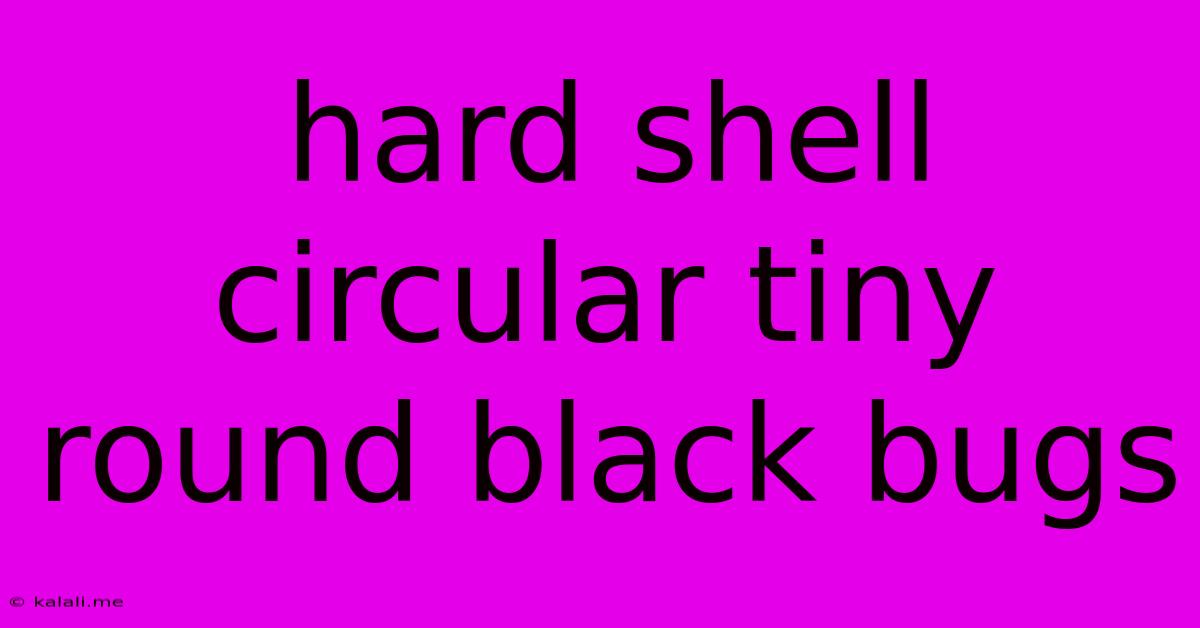Hard Shell Circular Tiny Round Black Bugs
Kalali
Jun 05, 2025 · 3 min read

Table of Contents
Identifying and Dealing with Tiny, Hard-Shelled, Black, Round Bugs
Are you dealing with an infestation of small, hard-shelled, black, round bugs? This description covers several potential insect species, making accurate identification crucial for effective treatment. This article will explore common possibilities, their characteristics, and how to address the infestation. Understanding the culprit will help you choose the right course of action to regain control of your home or garden.
What Could These Bugs Be?
Several insect families fit the description of "tiny, hard-shelled, black, round bugs." Let's examine some of the most likely candidates:
1. Ground Beetles (Family Carabidae):
Many ground beetle species are small, dark-colored, and have a rounded or oval shape. They are often found near gardens and are generally beneficial, as they prey on other insects. However, a large infestation can still be concerning. Look for: well-defined head and thorax, strong mandibles (jaws), and long legs suited for running.
2. Seed Beetles (Family Bruchidae):
These tiny beetles are known for infesting stored seeds and grains. They are often black or dark brown and have a hard, rounded body. Look for: evidence of infestation in stored food items such as beans, peas, or rice. Adults are relatively small and may be found near the source of infestation.
3. Rove Beetles (Family Staphylinidae):
While some rove beetles might appear somewhat elongated, many smaller species exhibit a rounded appearance. They are often dark in color. Look for: short elytra (wing covers) that leave a significant portion of their abdomen exposed. They are generally scavengers but can be a nuisance in large numbers.
4. Other Potential Insects:
Other tiny, dark, rounded insects could be involved, depending on your location and environment. This could include specific species of weevils, dung beetles, or even some types of ants depending on the species. Accurate identification often requires closer examination or professional assistance.
How to Identify the Specific Bug:
To accurately identify the insect, consider these steps:
- Take a clear picture: Use a macro lens or a magnifying glass to capture detailed images.
- Note the size and shape: Precise measurements and descriptions are helpful.
- Observe their behavior: Where are they located? What are they doing? Are they active at night or during the day?
- Examine their habitat: Are they found in stored food, plants, soil, or other specific areas?
Dealing with the Infestation:
Once you've identified the insect, you can develop a targeted approach. General strategies include:
- Cleanliness: Thoroughly clean and vacuum affected areas. Dispose of infested food items properly.
- Natural Remedies: For some infestations, natural remedies like diatomaceous earth may be effective. However, effectiveness varies depending on the species.
- Pesticides: In severe cases, you may need to resort to insecticides. Always choose a product specifically designed for the identified insect and follow label instructions carefully. Consider professional pest control for significant infestations.
Prevention:
Preventing future infestations involves:
- Proper food storage: Store grains and other susceptible foods in airtight containers.
- Regular cleaning: Keep your home and garden clean and free of debris.
- Sealing entry points: Caulk cracks and crevices to prevent insects from entering.
Remember, accurate identification is key to effective pest control. If you are unable to identify the insects, consulting a professional entomologist or pest control service is recommended. They possess the expertise to pinpoint the species and recommend the most appropriate and safe treatment strategy.
Latest Posts
Latest Posts
-
Se Puede Deshacer El Rgb Outline En Illustrator
Jun 06, 2025
-
Reasons Cron Job Isnt Firing At A Given Time
Jun 06, 2025
-
Convert Latitude Longitude To State Plane Coordinates
Jun 06, 2025
-
Question Cheetah Find All The Stereocenters In
Jun 06, 2025
-
Why Negative Multiply Negative Is Positive
Jun 06, 2025
Related Post
Thank you for visiting our website which covers about Hard Shell Circular Tiny Round Black Bugs . We hope the information provided has been useful to you. Feel free to contact us if you have any questions or need further assistance. See you next time and don't miss to bookmark.